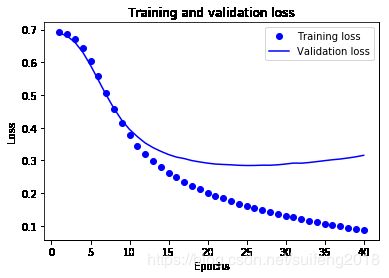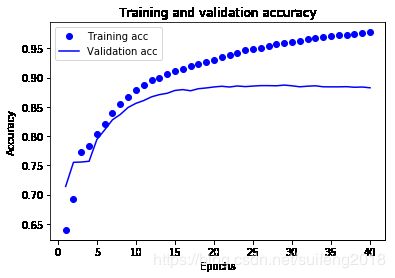NPL实践系列:1、探索NPL数据集
1、数据集来源
- 中文数据集:THUCNews
- THUCNews数据子集:https://pan.baidu.com/s/1hugrfRu 密码:qfud
- 英文数据集:IMDB数据集 Sentiment Analysis
2、IMDB数据探索
# 测试依赖包,TensorFlow版本
import tensorflow as tf
from tensorflow import keras
import numpy as np
print(tf.__version__)
1.12.0
# 下载数据集
imdb = keras.datasets.imdb
(train_data, train_labels), (test_data, test_labels) = imdb.load_data(num_words=10000)
探索测试数据集
print("Training entries: {}, labels: {}".format(len(train_data), len(train_labels)))
Training entries: 25000, labels: 25000
print(train_data[0])
[1, 14, 22, 16, 43, 530, 973, 1622, 1385, 65, 458, 4468, 66, 3941, 4, 173, 36, 256, 5, 25, 100, 43, 838, 112, 50, 670, 2, 9, 35, 480, 284, 5, 150, 4, 172, 112, 167, 2, 336, 385, 39, 4, 172, 4536, 1111, 17, 546, 38, 13, 447, 4, 192, 50, 16, 6, 147, 2025, 19, 14, 22, 4, 1920, 4613, 469, 4, 22, 71, 87, 12, 16, 43, 530, 38, 76, 15, 13, 1247, 4, 22, 17, 515, 17, 12, 16, 626, 18, 2, 5, 62, 386, 12, 8, 316, 8, 106, 5, 4, 2223, 5244, 16, 480, 66, 3785, 33, 4, 130, 12, 16, 38, 619, 5, 25, 124, 51, 36, 135, 48, 25, 1415, 33, 6, 22, 12, 215, 28, 77, 52, 5, 14, 407, 16, 82, 2, 8, 4, 107, 117, 5952, 15, 256, 4, 2, 7, 3766, 5, 723, 36, 71, 43, 530, 476, 26, 400, 317, 46, 7, 4, 2, 1029, 13, 104, 88, 4, 381, 15, 297, 98, 32, 2071, 56, 26, 141, 6, 194, 7486, 18, 4, 226, 22, 21, 134, 476, 26, 480, 5, 144, 30, 5535, 18, 51, 36, 28, 224, 92, 25, 104, 4, 226, 65, 16, 38, 1334, 88, 12, 16, 283, 5, 16, 4472, 113, 103, 32, 15, 16, 5345, 19, 178, 32]
len(train_data[0]), len(train_data[1])
(218, 189)
# A dictionary mapping words to an integer index
word_index = imdb.get_word_index()
# The first indices are reserved
word_index = {k:(v+3) for k,v in word_index.items()}
word_index["" ] = 0
word_index["" ] = 1
word_index["" ] = 2 # unknown
word_index["" ] = 3
reverse_word_index = dict([(value, key) for (key, value) in word_index.items()])
def decode_review(text):
return ' '.join([reverse_word_index.get(i, '?') for i in text])
decode_review(train_data[0])
" this film was just brilliant casting location scenery story direction everyone's really suited the part they played and you could just imagine being there robert is an amazing actor and now the same being director father came from the same scottish island as myself so i loved the fact there was a real connection with this film the witty remarks throughout the film were great it was just brilliant so much that i bought the film as soon as it was released for and would recommend it to everyone to watch and the fly fishing was amazing really cried at the end it was so sad and you know what they say if you cry at a film it must have been good and this definitely was also to the two little boy's that played the of norman and paul they were just brilliant children are often left out of the list i think because the stars that play them all grown up are such a big profile for the whole film but these children are amazing and should be praised for what they have done don't you think the whole story was so lovely because it was true and was someone's life after all that was shared with us all"
使用 pad_sequences 函数将长度标准化:
train_data = keras.preprocessing.sequence.pad_sequences(train_data,
value=word_index["" ],
padding='post',
maxlen=256)
test_data = keras.preprocessing.sequence.pad_sequences(test_data,
value=word_index["" ],
padding='post',
maxlen=256)
len(train_data[0]), len(train_data[1])
(256, 256)
print(train_data[0])
[ 1 14 22 16 43 530 973 1622 1385 65 458 4468 66 3941 4
173 36 256 5 25 100 43 838 112 50 670 2 9 35 480
284 5 150 4 172 112 167 2 336 385 39 4 172 4536 1111
17 546 38 13 447 4 192 50 16 6 147 2025 19 14 22
4 1920 4613 469 4 22 71 87 12 16 43 530 38 76 15
13 1247 4 22 17 515 17 12 16 626 18 2 5 62 386
12 8 316 8 106 5 4 2223 5244 16 480 66 3785 33 4
130 12 16 38 619 5 25 124 51 36 135 48 25 1415 33
6 22 12 215 28 77 52 5 14 407 16 82 2 8 4
107 117 5952 15 256 4 2 7 3766 5 723 36 71 43 530
476 26 400 317 46 7 4 2 1029 13 104 88 4 381 15
297 98 32 2071 56 26 141 6 194 7486 18 4 226 22 21
134 476 26 480 5 144 30 5535 18 51 36 28 224 92 25
104 4 226 65 16 38 1334 88 12 16 283 5 16 4472 113
103 32 15 16 5345 19 178 32 0 0 0 0 0 0 0
0 0 0 0 0 0 0 0 0 0 0 0 0 0 0
0 0 0 0 0 0 0 0 0 0 0 0 0 0 0
0]
构建模型
# input shape is the vocabulary count used for the movie reviews (10,000 words)
vocab_size = 10000
model = keras.Sequential()
model.add(keras.layers.Embedding(vocab_size, 16))
model.add(keras.layers.GlobalAveragePooling1D())
model.add(keras.layers.Dense(16, activation=tf.nn.relu))
model.add(keras.layers.Dense(1, activation=tf.nn.sigmoid))
model.summary()
_________________________________________________________________
Layer (type) Output Shape Param #
=================================================================
embedding (Embedding) (None, None, 16) 160000
_________________________________________________________________
global_average_pooling1d (Gl (None, 16) 0
_________________________________________________________________
dense (Dense) (None, 16) 272
_________________________________________________________________
dense_1 (Dense) (None, 1) 17
=================================================================
Total params: 160,289
Trainable params: 160,289
Non-trainable params: 0
_________________________________________________________________
使用 Keras Sequential 顺序模型,它由多个网络层线性堆叠,上面的模型,结构如下:
1、第一层是 Embedding 层。该层会在整数编码的词汇表中查找每个字词-索引的嵌入向量。模型在接受训练时会学习这些向量。这些向量会向输出数组添加一个维度。生成的维度为:(batch, sequence, embedding)。
2、接下来,一个 GlobalAveragePooling1D 层通过对序列维度求平均值,针对每个样本返回一个长度固定的输出向量。这样,模型便能够以尽可能简单的方式处理各种长度的输入。
3、该长度固定的输出向量会传入一个全连接 (Dense) 层(包含 16 个隐藏单元)。
4、最后一层与单个输出节点密集连接。应用 sigmoid 激活函数后,结果是介于 0 到 1 之间的浮点值,表示概率或置信水平。
model.compile(optimizer=tf.train.AdamOptimizer(),
loss='binary_crossentropy',
metrics=['accuracy'])
x_val = train_data[:10000]
partial_x_train = train_data[10000:]
y_val = train_labels[:10000]
partial_y_train = train_labels[10000:]
history = model.fit(partial_x_train,
partial_y_train,
epochs=40,
batch_size=512,
validation_data=(x_val, y_val),
verbose=1)
Train on 15000 samples, validate on 10000 samples
Epoch 1/40
15000/15000 [==============================] - 9s 622us/step - loss: 0.6918 - acc: 0.6397 - val_loss: 0.6898 - val_acc: 0.7141
Epoch 2/40
15000/15000 [==============================] - 2s 140us/step - loss: 0.6854 - acc: 0.6933 - val_loss: 0.6802 - val_acc: 0.7552
Epoch 3/40
15000/15000 [==============================] - 2s 152us/step - loss: 0.6703 - acc: 0.7735 - val_loss: 0.6611 - val_acc: 0.7557
Epoch 4/40
15000/15000 [==============================] - 2s 129us/step - loss: 0.6436 - acc: 0.7826 - val_loss: 0.6312 - val_acc: 0.7570
Epoch 5/40
15000/15000 [==============================] - 1s 94us/step - loss: 0.6048 - acc: 0.8029 - val_loss: 0.5909 - val_acc: 0.7942
Epoch 6/40
15000/15000 [==============================] - 1s 97us/step - loss: 0.5574 - acc: 0.8209 - val_loss: 0.5458 - val_acc: 0.8107
Epoch 7/40
15000/15000 [==============================] - 1s 92us/step - loss: 0.5065 - acc: 0.8401 - val_loss: 0.5007 - val_acc: 0.8279
Epoch 8/40
15000/15000 [==============================] - 2s 130us/step - loss: 0.4583 - acc: 0.8541 - val_loss: 0.4591 - val_acc: 0.8370
Epoch 9/40
15000/15000 [==============================] - 2s 114us/step - loss: 0.4141 - acc: 0.8675 - val_loss: 0.4234 - val_acc: 0.8490
Epoch 10/40
15000/15000 [==============================] - 2s 104us/step - loss: 0.3768 - acc: 0.8791 - val_loss: 0.3948 - val_acc: 0.8560
Epoch 11/40
15000/15000 [==============================] - 2s 100us/step - loss: 0.3454 - acc: 0.8875 - val_loss: 0.3730 - val_acc: 0.8608
Epoch 12/40
15000/15000 [==============================] - 1s 94us/step - loss: 0.3198 - acc: 0.8955 - val_loss: 0.3536 - val_acc: 0.8671
Epoch 13/40
15000/15000 [==============================] - 1s 89us/step - loss: 0.2979 - acc: 0.9001 - val_loss: 0.3394 - val_acc: 0.8709
Epoch 14/40
15000/15000 [==============================] - 2s 118us/step - loss: 0.2791 - acc: 0.9055 - val_loss: 0.3280 - val_acc: 0.8732
Epoch 15/40
15000/15000 [==============================] - 1s 95us/step - loss: 0.2625 - acc: 0.9105 - val_loss: 0.3181 - val_acc: 0.8780
Epoch 16/40
15000/15000 [==============================] - 1s 81us/step - loss: 0.2481 - acc: 0.9155 - val_loss: 0.3104 - val_acc: 0.8795
Epoch 17/40
15000/15000 [==============================] - 1s 88us/step - loss: 0.2354 - acc: 0.9192 - val_loss: 0.3059 - val_acc: 0.8775
Epoch 18/40
15000/15000 [==============================] - 1s 87us/step - loss: 0.2230 - acc: 0.9235 - val_loss: 0.2996 - val_acc: 0.8810
Epoch 19/40
15000/15000 [==============================] - 2s 120us/step - loss: 0.2126 - acc: 0.9272 - val_loss: 0.2955 - val_acc: 0.8823
Epoch 20/40
15000/15000 [==============================] - 1s 87us/step - loss: 0.2021 - acc: 0.9303 - val_loss: 0.2918 - val_acc: 0.8840
Epoch 21/40
15000/15000 [==============================] - 1s 89us/step - loss: 0.1927 - acc: 0.9350 - val_loss: 0.2891 - val_acc: 0.8852
Epoch 22/40
15000/15000 [==============================] - 1s 89us/step - loss: 0.1841 - acc: 0.9386 - val_loss: 0.2878 - val_acc: 0.8839
Epoch 23/40
15000/15000 [==============================] - 1s 87us/step - loss: 0.1761 - acc: 0.9420 - val_loss: 0.2867 - val_acc: 0.8857
Epoch 24/40
15000/15000 [==============================] - 1s 90us/step - loss: 0.1685 - acc: 0.9465 - val_loss: 0.2853 - val_acc: 0.8846
Epoch 25/40
15000/15000 [==============================] - 2s 115us/step - loss: 0.1613 - acc: 0.9487 - val_loss: 0.2846 - val_acc: 0.8855
Epoch 26/40
15000/15000 [==============================] - 2s 106us/step - loss: 0.1547 - acc: 0.9514 - val_loss: 0.2848 - val_acc: 0.8863
Epoch 27/40
15000/15000 [==============================] - 1s 81us/step - loss: 0.1480 - acc: 0.9543 - val_loss: 0.2856 - val_acc: 0.8863
Epoch 28/40
15000/15000 [==============================] - 1s 86us/step - loss: 0.1421 - acc: 0.9567 - val_loss: 0.2855 - val_acc: 0.8860
Epoch 29/40
15000/15000 [==============================] - 1s 84us/step - loss: 0.1361 - acc: 0.9596 - val_loss: 0.2868 - val_acc: 0.8872
Epoch 30/40
15000/15000 [==============================] - 1s 97us/step - loss: 0.1309 - acc: 0.9609 - val_loss: 0.2891 - val_acc: 0.8860
Epoch 31/40
15000/15000 [==============================] - 2s 111us/step - loss: 0.1258 - acc: 0.9631 - val_loss: 0.2920 - val_acc: 0.8843
Epoch 32/40
15000/15000 [==============================] - 1s 88us/step - loss: 0.1208 - acc: 0.9655 - val_loss: 0.2917 - val_acc: 0.8853
Epoch 33/40
15000/15000 [==============================] - 1s 84us/step - loss: 0.1160 - acc: 0.9684 - val_loss: 0.2937 - val_acc: 0.8860
Epoch 34/40
15000/15000 [==============================] - 1s 90us/step - loss: 0.1113 - acc: 0.9699 - val_loss: 0.2965 - val_acc: 0.8843
Epoch 35/40
15000/15000 [==============================] - 1s 87us/step - loss: 0.1069 - acc: 0.9711 - val_loss: 0.2994 - val_acc: 0.8842
Epoch 36/40
15000/15000 [==============================] - 1s 81us/step - loss: 0.1028 - acc: 0.9725 - val_loss: 0.3022 - val_acc: 0.8842
Epoch 37/40
15000/15000 [==============================] - 1s 87us/step - loss: 0.0994 - acc: 0.9735 - val_loss: 0.3044 - val_acc: 0.8845
Epoch 38/40
15000/15000 [==============================] - 1s 87us/step - loss: 0.0948 - acc: 0.9753 - val_loss: 0.3076 - val_acc: 0.8835
Epoch 39/40
15000/15000 [==============================] - 1s 83us/step - loss: 0.0911 - acc: 0.9766 - val_loss: 0.3112 - val_acc: 0.8839
Epoch 40/40
15000/15000 [==============================] - 1s 87us/step - loss: 0.0878 - acc: 0.9775 - val_loss: 0.3158 - val_acc: 0.8826
results = model.evaluate(test_data, test_labels)
print(results)
25000/25000 [==============================] - 4s 144us/step
[0.3395507445144653, 0.86964]
history_dict = history.history
history_dict.keys()
dict_keys(['val_loss', 'val_acc', 'loss', 'acc'])
import matplotlib.pyplot as plt
acc = history.history['acc']
val_acc = history.history['val_acc']
loss = history.history['loss']
val_loss = history.history['val_loss']
epochs = range(1, len(acc) + 1)
# "bo" is for "blue dot"
plt.plot(epochs, loss, 'bo', label='Training loss')
# b is for "solid blue line"
plt.plot(epochs, val_loss, 'b', label='Validation loss')
plt.title('Training and validation loss')
plt.xlabel('Epochs')
plt.ylabel('Loss')
plt.legend()
plt.show()
plt.clf() # clear figure
acc_values = history_dict['acc']
val_acc_values = history_dict['val_acc']
plt.plot(epochs, acc, 'bo', label='Training acc')
plt.plot(epochs, val_acc, 'b', label='Validation acc')
plt.title('Training and validation accuracy')
plt.xlabel('Epochs')
plt.ylabel('Accuracy')
plt.legend()
plt.show()
3、准确率(Precision)、精确率(精准率)、召回率(Recall)概念
- 在机器学习、数据挖掘、推荐系统完成建模之后,需要对模型的效果做评价。
对于二分类问题,业内目前常常采用的评价指标有准确率(Precision)、召回率(Recall)等
TP——正类判别成正类
FN——正类判别成负类
FP——负类判别成正类
TN——负类判别成负类 - 准确率(Accuracy)
准确率(accuracy)计算公式为:

准确率是我们最常见的评价指标,而且很容易理解,就是被分对的样本数除以所有的样本数,通常来说,正确率越高,分类器越好。
准确率确实是一个很好很直观的评价指标,但是有时候准确率高并不能代表一个算法就好。比如某个地区某天地震的预测,假设我们有一堆的特征作为地震分类的属性,类别只有两个:0:不发生地震、1:发生地震。一个不加思考的分类器,对每一个测试用例都将类别划分为0,那那么它就可能达到99%的准确率,但真的地震来临时,这个分类器毫无察觉,这个分类带来的损失是巨大的。为什么99%的准确率的分类器却不是我们想要的,因为这里数据分布不均衡,类别1的数据太少,完全错分类别1依然可以达到很高的准确率却忽视了我们关注的东西。再举个例子说明下。在正负样本不平衡的情况下,准确率这个评价指标有很大的缺陷。比如在互联网广告里面,点击的数量是很少的,一般只有千分之几,如果用acc,即使全部预测成负类(不点击)acc也有 99% 以上,没有意义。因此,单纯靠准确率来评价一个算法模型是远远不够科学全面的。 - 精确率、精准率(Precision)
公式:

表示被分为正例的示例中实际为正例的比例。 - 召回率(recall)
公式:

召回率是覆盖面的度量,度量有多个正例被分为正例,recall=TP/(TP+FN)=TP/P=sensitive,可以看到召回率与灵敏度是一样的。
4、ROC曲线、AUC、和PR曲线了解
-
ROC曲线和PR(Precision - Recall)曲线皆为类别不平衡问题中常用的评估方法,二者既有相同也有不同点。
-
ROC曲线常用于二分类问题中的模型比较,主要表现为一种真正例率 (TPR) 和假正例率 (FPR) 的权衡。具体方法是在不同的分类阈值 (threshold) 设定下分别以TPR和FPR为纵、横轴作图。由ROC曲线的两个指标,TPR=TPP=TPTP+FNTPR=TPP=TPTP+FN,FPR=FPN=FPFP+TNFPR=FPN=FPFP+TN可以看出,当一个样本被分类器判为正例,若其本身是正例,则TPR增加;若其本身是负例,则FPR增加,因此ROC曲线可以看作是随着阈值的不断移动,所有样本中正例与负例之间的“对抗”。曲线越靠近左上角,意味着越多的正例优先于负例,模型的整体表现也就越好。
-
AUC 即ROC曲线围成的面积,可以理解为:从所有正例中随机选取一个样本A,再从所有负例中随机选取一个样本B,分类器将A判为正例的概率比将B判为正例的概率大的可能性。可以看到位于随机线上方的点(如图中的A点)被认为好于随机猜测。在这样的点上TPR总大于FPR,意为正例被判为正例的概率大于负例被判为正例的概率。
-
PR曲线展示的是Precision vs Recall的曲线,PR曲线与ROC曲线的相同点是都采用了TPR (Recall),都可以用AUC来衡量分类器的效果。不同点是ROC曲线使用了FPR,而PR曲线使用了Precision,因此PR曲线的两个指标都聚焦于正例。类别不平衡问题中由于主要关心正例,所以在此情况下PR曲线被广泛认为优于ROC曲线。
参考链接 : https://www.imooc.com/article/48072
https://tensorflow.google.cn/tutorials/keras/basic_text_classification
https://www.cnblogs.com/Zhi-Z/p/8728168.html

